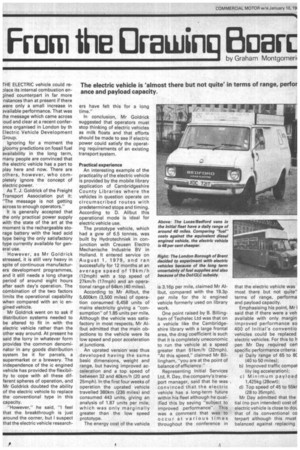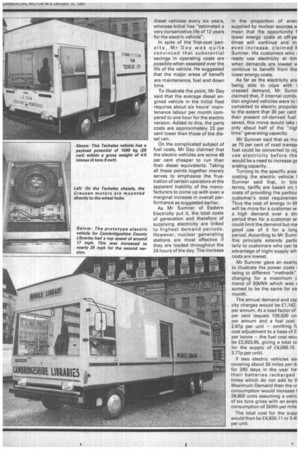From the Drawing Pp pFc w
Page 44

Page 45

If you've noticed an error in this article please click here to report it so we can fix it.
THE ELECTRIC vehicle could replace its internal combustion engined counterpart in far more nstances than at present if there Mere only a small increase in Avai la ble performance. That was the message which came across aud and clear at a recent conference organised in London by th Electric Vehicle Development Group.
Ignoring for a moment the gloomy predictions on fossil fuel availability in the long term, many people are convinced that the electric vehicle has a part to play here and now. There are others, however, who completely ignore the concept of electric power. '
As T. J. Goldrick of the Freight Transport Association put it: "The message is not getting across to enough operators."
It is generally accepted that the only practical power supply with the state of the art at the moment is the rechargeable storage battery with the lead acid type being the only satisfactory type currently available for general use.
However, as Mr Goldrick stressed, it is still very heavy in spite of continuous manufacturers development programmes, and it still needs a long charge period of around eight hours after each day's operation. The combination of the two factors limits the operational capability when compared with an ic engined vehicle.
Mr Goldrick went on to ask if distribution systems needed to be altered to fit in with the electric vehicle rather than the other way around. At present he said the lorry in whatever form provides the common denominator in any goods distribution system be it for parcels, a supermarket or a brewery. The independence of the ic engined vehicle has provided the flexibility to cope with all these different spheres of operation, and Mr Goldrick doubted the ability of the electric vehicle to replace the conventional type in this capacity.
"However," he said, "I feel that the breakthrough is just around the corner, but I suspect that the electric vehicle research
ers have felt this for a long time."
In conclusion, Mr Goldrick suggested that operators must stop thinking of electric vehicles as milk floats and that efforts should be made to see if electric power could satisfy the operating requirements of an existing transport system.
Practical experience An interesting example of the practicality of the electric vehicle is provided by the mobile library application of Cambridgeshire County Libraries where the vehicles in question operate on circumscribed routes with predetermined stops and timing. According to D. Allbut this operational mode is ideal for electric vehicle use.
The prototype 'vehicle, which had a gvw of 6.5 tonnes, was 'built by Hydrotechniek in conjunction with Creusen Electro Mechanische Industrie BV in Holland. It entered service on August 1, 1979, and ran successfully for 12 months at an average speed of 19 km/h (12mph) with a top speed of 27km/h (17mph) and an operational range of 64km (40 miles).
According to Mr Allbut, the 5,600km (3,500 miles) of operation consumed 6,458 units of mains electricity giving a "consumption" of 1.85 units per mile. Although the vehicle was satisfactory in most respects, Mr Allbut admitted that the main objections to the vehicle were its low speed and poor acceleration at junctions.
An uprated version was thus .developed having the same basic dimensions, weight and range, but having improved acceleration and a top speed of between 32 and 40km/h (20 and 25mph). In the first four vveeks of operation the uprated vehicle travelled 380km (236 miles) and consumed 443 units, giving an analysis of 1.87 units per mile, which was only marginally greater than the low speed prototype.
The energy cost of the vehicle is 3.16p per mile, claimed Mr Allbut, compared with the 19.3p per mile for the ic engined vehicle formerly used on library work.
One point raised by B. Billingham of Techelec Ltd was that on a vehicle like the Cambridgeshire library with a large frontal area, the drag coefficient is such that it is completely uneconomic to run the vehicle at a speed greater than 51km/h (32mph). "At this speed," claimed Mr Billingham, "you are at the point of balance of efficiency."
Representing Initial Services Ltd, R. Day, the company's transport manager, said that he was convinced that the electric vehicle has a long-term future within his fleet although he qualified this by saying "subject to improved performance". This was a comment that was to occur at various times throughout the conference in that the electric vehicle was most there but not quite" terms of range, performa and payload capacity. .
Emphasising his point, Mr I said that if there were a veh available with only margin improved performance so 400 of Initial's conventio vehicles could be replaced electric vehicles. For this to h pen Mr Day required cen specific performance criteria: a) Daily range of 65 to 8C (40 to 50 miles); b) Improved traffic com pat lity (eg acceleration); c) Minimum payload 1,425kg (28cwt); d) Top speed of 45 to 55kr (28 to 35mph).
Mr Day admitted that the tial (no pun intended) cost of electric vehicle is close to doL that of its conventional co terpart although this must balanced against replacing diesel vehicles every six years, whereas Initial has "estimated a very conservative life of 12 years for the electric vehicle".
In spite of the first-cost penalty, Mr Day was quite convinced that substantial savings in operating costs are possible when assessed over the life of the vehicle. He suggested that the major areas of benefit are maintenance, fuel and down time.
To illustrate the point, Mr Day said that the average diesel engined vehicle in the Initial fleet requires about six hours' maintenance labour per month compared to one hour for the electric version. Added to this, the parts costs are approximately 23 per cent lower than those of the diesel van.
On the complicated subject of fuel costs, Mr Day claimed that the electric vehicles are some 48 per cent cheaper to run than their diesel equivalents. Taking all these points together merely serves to emphasise the frustration of certain operators at the apparent inability of the manufacturers to come up with even a marginal increase in overall performance as suggested earlier.
As Mr Sumner of Eastern Electricity put it, the total costs of generation and therefore of supplying electricity are linked to highest demand periods. However, nuclear generating stations are most effective if they are loaded throughout the 24 hours of the day. The increase
in the proportion of enen supplied by nuclear sources vs mean that the opportunity f lower energy costs at off-pe times will continue and m, even increase, claimed 11 Sumner. His customers who ready use electricity at tim when demands are lowest vs, continue to benefit from the lower energy costs.
As far as the electricity are being able to cope with i creased demand, Mr Sumn claimed that, if internal comb'. tion engined vehicles were to I converted to electric propulsi( to the extent that 30 per cent their present oil-derived fuel saved, this move would take only about half of the "nigt time" generating capacity.
Mr Sumner said that as mu as 70 per cent of road transp( fuel could be converted to nic_ use electricity before the would be a need to increase gE erating capacity.
Turning to the specific area costing the electric vehicle I Sumner said that, in bro terms, tariffs are based on t costs of providing the particu customer's total requiremen Thus the cost of energy in kV will be more for a customer vV a high demand over a sh( period than for a customer wl could limit the demand but ma good use of it for a long period. According to Mr Sumn this principle extends panic larly to customers who can ta advantage of night supply wh costs are lowest.
Mr Sumner gave an examq to illustrate the power costs lating to different "methods" charging for a maximum c mand of 50kWh which was E sUmed to be the same for ea month.
The annual demand and cap city charges would be £1,142. per annum. At a load factor of : per cent (equals 109,500 un per annum and a fuel cost 2.67p per unit — omitting ft cost adjustment to a base of C: per tonne — the fuel cost wou be £2,923.65, giving a total cc for the supply of £4,066.15 3.71p per unit}.
If two electric vehicles cal covering about 30 miles per for 240 days in the year ha, their batteries recharged times which do not add to ti Maximum Demand then the If consumption would increase 1 28,800 units assuming a vehic of six tons gross with an erier[ consumption of 2kWh per mile
The total cost for the supp would then be £4,835.11 or 3.4f. per unit.




























































































